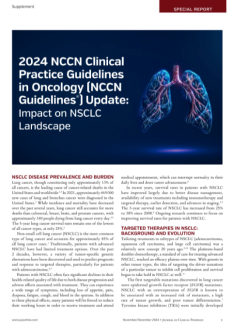Molecular Classification Drives Advances in Endometrial Cancer Treatment
In this interview, Brian M. Slomovitz, MD, MS, discusses the impact of molecular classification on endometrial cancer treatment, the role of biomarkers in guiding therapy, and the promise of emerging strategies to address challenges in advanced and recurrent disease.
Please state your name, title, and any relevant clinical experience
Brian M. Slomovitz, MD, MS: I am Brian Slomovitz, Director of Gynecologic Oncology at Mount Sinai Medical Center in Miami Beach, Florida. I also serve as the uterine cancer clinical trial lead for the GOG Partners, part of the GOG Foundation.
 How has the molecular classification of endometrial cancer influenced treatment strategies, and what are the potential benefits of tailoring therapies based on specific molecular subtypes?
How has the molecular classification of endometrial cancer influenced treatment strategies, and what are the potential benefits of tailoring therapies based on specific molecular subtypes?
Dr Slomovitz: It's a game changer. The Cancer Genome Atlas (TCGA) data in 2013, followed by the Patient-Reported Outcomes Measurement Information System (PROMIS), divided endometrial cancers into 4 molecular subtypes: POLE mutations, deficient mismatch repair (dMMR), no specific molecular profile (NSMP), and p53-mutated. These subtypes define prognostic categories and are helping us delineate treatment options.
For instance, the POLE mutations and the MSI-high tumors are amenable to single-agent immunotherapy. Conversely, others, such as cold tumors, often require lenvatinib in combination with immunotherapy in the endometrial setting. Both now and moving forward, it's a game changer. It’s almost mandatory to consider the molecular classification of a tumor when developing better treatment options for patients with advanced and recurrent disease.
What is the current understanding of biomarkers in predicting treatment response and prognosis in endometrial cancer, and how might emerging biomarkers enhance personalized treatment approaches?
Dr Slomovitz: Currently, the biomarkers we test, for the most part, are mismatched repair proteins. We do p53 testing, estrogen receptor (ER), progesterone receptor (PR), and HER2 testing as well. These biomarkers provide important prognostic information. For example, patients with POLE mutations have the best prognosis, while those with p53 mutations have the worst.
Regarding treatment response, we know with immunotherapy, for example, that single-agent immunotherapy is effective in the dMMR population. However, in the proficient mismatch repair (pMMR) population, immunotherapy as a single agent is less effective. Overall, biomarkers are critical from both a prognostic and predictive perspective, and we have to be incorporating them into the treatment of patients with endometrial cancer.
What are the current strategies for managing recurrent endometrial cancer, and how do emerging therapies aim to address challenges associated with treatment resistance?
Dr Slomovitz: In the first-line setting for women with advanced or recurrent disease, the best treatment option currently, and one that is FDA approved, is chemotherapy plus checkpoint inhibitors. This is applicable whether patients have dMMR or pMMR. I'd say it's a required option for patients with dMMR, while for those with pMMR, it remains an option.
There's also a role for other approaches, such as no maintenance therapy, bevacizumab, or selinexor maintenance therapy. For patients with pMMR, there are additional options with FDA approvals for all comers.
With the approvals of drugs like dostarlimab and pembrolizumab in combination with chemotherapy for certain types of endometrial cancer, how have these approvals changed clinical practice, and what should clinicians consider when integrating these options into treatment plans?
Dr Slomovitz: These approvals have shifted the treatment paradigm in 2 significant ways. First, the benefit of these therapies in the-first line setting has been demonstrated, as reported in the New England Journal in March of 2023. Second, this has led to the earlier integration of immune checkpoint inhibitors (IO) into first-line therapy, creating an unmet need in the second- and third-line settings.
Ongoing studies are exploring options such as antibody-drug conjugates (ADCs), hormonal therapies, and other biomarker-driven therapies. However, we currently lack data to support the use of immunotherapy after prior immunotherapy. Once patients have received immunotherapy, there is no evidence or rationale to give it again at this time. It's an exciting time in endometrial cancer research, and there are a lot of opportunities that we need to further explore.
What are the key areas of research and development in endometrial cancer treatment, and how do you envision the treatment landscape evolving in the next 5 to 10 years?
Dr Slomovitz: ADCs are a major focus. HER2-targeted ADCs, such as trastuzumab deruxtecan, have shown promise, and there’s strong data supporting HER2-targeted therapies. TROP2 ADCs, includ9ing sacituzumab govitecan, are currently in phase III trials, and pembrolizumab has also been incorporated into this research. There was alsorecent data presented at ESMO highlighting the potential of durvalumab.
B7H4 is another exciting marker to look forward to. We are also exploring opportunities with CDK4/6 and mTOR inhibitors, WEE1 inhibitors, and other methods to target the CCNE pathway. There are a lot of options on the horizon, but we need to continue pushing forward and looking at our work to better address the needs of patients with endometrial cancer.
© 2024 HMP Global. All Rights Reserved.
Any views and opinions expressed are those of the author(s) and/or participants and do not necessarily reflect the views, policy, or position of the Journal of Clinical Pathways or HMP Global, their employees, and affiliates.

















